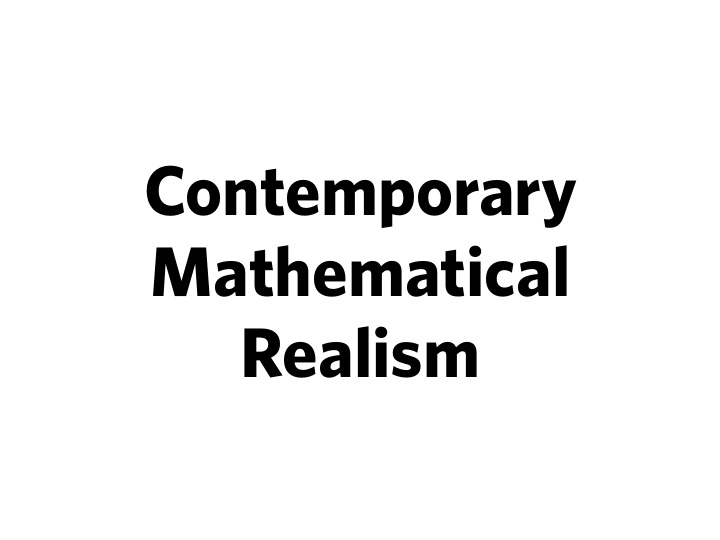



Contemporary Mathematical Realism
Kurt Gödel
THE VICIOUS - CIRCLE PRINCIPLE “ Ti e principle which enables us to avoid illegitimate totalities may be stated as follows: “Whatever involves all of a collection must not be one of the collection”; or, conversely: “If, provided a certain collection had a total, it would have members only de fi nable in terms of that total, then the said collection has no total.” We shall call this the “vicious-circle principle,” because it enables us to avoid the vicious circles involved in the assumption of illegitimate totalities.” —Whitehead and Russell, Principia Mathematica
The laws of Scientific Theories physics PREDICTION + EXPLANATION If [laws of physics], then [observations]. I observe … in …… Empirical Observations circumstances.
Mathematical e.g. Set theory Theories PREDICTION + EXPLANATION [mathematical theory] PROOF if and only if [mathematical axioms]. Mathematical e.g. 1+1 = 2 Axioms
Cantor’s Diagonal Proof (Unrigorous Philosophy Class Version) Natural Numbers (roughly): The counting numbers starting at 0 and going up Real Numbers (roughly): Any positive or negative number that can be represented as a (possibly infinitely long) decimal string. Conclusion: The infinite set of real numbers is “larger than” the infinite set of natural numbers.
Continuum Hypothesis (Unrigorous Philosophy Class Version) Question: Is there a distinct size of infinity that lies between the size of the natural numbers and the size of the real numbers? The Continuum Hypothesis: No, there is not. What Gödel and Paul Cohen Showed: Neither the continuum hypothesis nor its negation follows from the mathematical axioms we currently have. One possible conclusion There is no fact of the matter about whether the continuum hypothesis is true. Gödel drew a different conclusion: We need more axioms!
WILLARD VAN ORMAN QUINE
“ Ti e totality of our so-called knowledge or beliefs, from the most casual matters of geography and history to the profoundest laws of atomic physics or even of pure mathematics and logic, is a man- made fabric which impinges on experience only along the edges.” Quine
“Or, to change the fi gure, total science is like a fi eld of force whose boundary conditions are experience. A con fl ict with experience at the periphery occasions readjustments in the interior of the fi eld. Truth values have to be redistributed over some of our statements. Re-evaluation of some statements entails re- evaluation of others, because of their logical interconnections—the logical laws being in turn simply certain further statements of the system, certain further elements of the fi eld.” Quine
The Web of Belief fewer more logical connections to connections to other other beliefs beliefs
The Web of Belief less likely to be more likely to be revised in light of revised in light of new experience new experience
“But the total fi eld is so undetermined by its boundary conditions, experience, that there is much latitude of choice as to what statements to re-evaluate in the light of any single contrary experience. No particular experiences are linked with any particular statements in the interior of the fi eld, except indirectly through considerations of equilibrium a ff ecting the fi eld as a whole.” Quine
“If this view is right, it is misleading to speak of the empirical content of an individual statement— especially if it be a statement at all remote from the experiential periphery of the fi eld.” Quine
“Furthermore it becomes folly to seek a boundary between synthetic statements, which hold contingently on experience, and analytic statements which hold come what may. Any statement can be held true come what may, if we make drastic enough adjustments elsewhere in the system. Even a statement very close to the periphery can be held true in the face of recalcitrant experience by pleading hallucination or by amending certain statements of the kind called logical laws. Conversely, by the same token, no statement is immune to revision.” Quine
The Web of Belief that that I am 2+2=4 seeing something beige
Quine’s method in ontology Step 1: Articulate your overall best theory of the world Make a list of all of the sentences that we have good reason to think are true. Step 2: Regimentation Translate all of the sentences into first-order predicate logic, taking care to paraphrase away as many unnecessary things as possible. Step 3: Check which existence claims are made Check what has to exist in order for the sentences to be true. (See which existential quantifications are made.)
The Indispensability Argument
The Indispensability Argument *Note: This argument does not work for all of mathematics!
Penelope Maddy b.1950
Recommend
More recommend